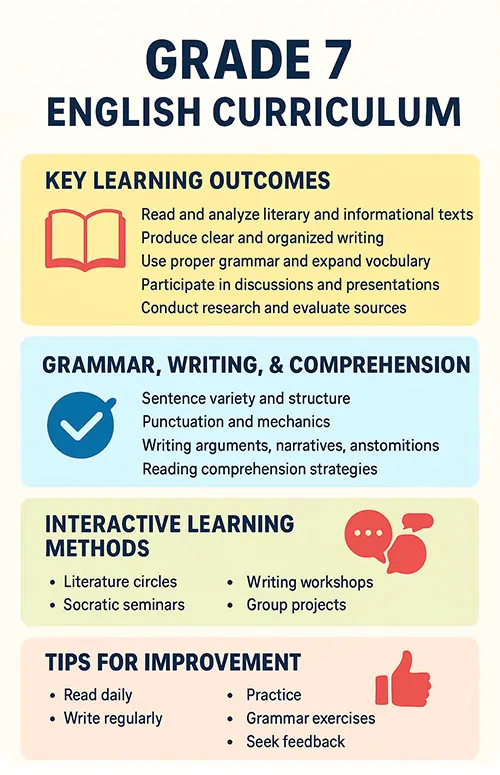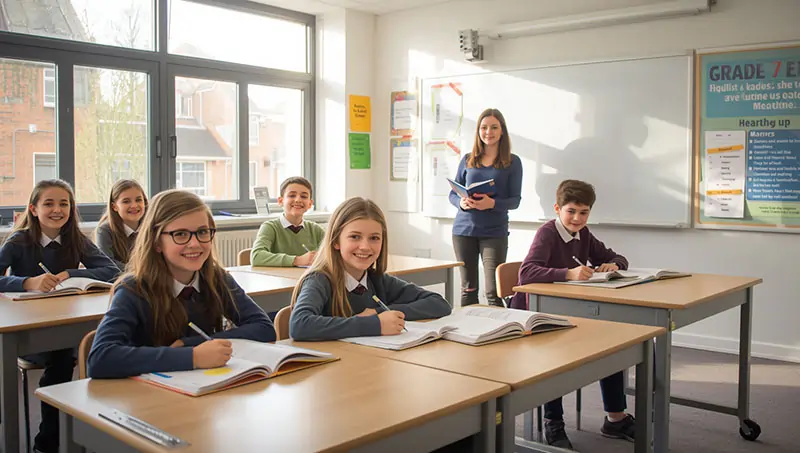Comprehensive English Curriculum for Grade 7
A good Grade 7 English program should include reading, writing, grammar, vocabulary, speaking, listening, and media literacy, and it should keep students interested and moving toward mastery. You can use or change the 1500-word framework below for your classroom or homeschool plan. For teachers looking for ready-to-use materials, KidsWorldFun offers English learning resources that can supplement lessons with worksheets, activities, and reading passages.
1) Key Learning Outcomes
By the end of Grade 7, students should be able to:
- Reading & Literature
- Read and write at grade level and use strategic annotation to find central ideas, themes, key details, and the author’s craft (tone, figurative language, and structure).
- Give proof to back up your ideas and compare how two texts deal with the same subjects.
- Writing
- Make clear, well-organized arguments, informational pieces, and stories that use strong thesis statements, logical structure, and cohesive devices (like transitions and parallelism).
- Improve your writing by going through the steps of planning, drafting, peer review, editing, and publishing.
- Use MLA-style basics (italics/quotes for titles, page numbers) and give proper credit for textual evidence.
- Grammar and Vocabulary:
- Control the ends of sentences (don’t let them run on or break), use different types of sentences, and keep the tense the same.
- Use punctuation (commas with clauses, semicolons/colons, quotation marks) and mechanics correctly.
- Use morphology (prefixes, suffixes, and roots) and context clues to help you learn new academic words.
- Speaking and Listening:
- Take part in group discussions, present your findings in an organized way with visuals, and respond with proof.
- Research and Media Literacy:
- Do short research projects, check the reliability of sources, and put together new work using information from different sources.
- Understand how to read graphs, infographics, and videos and see bias and purpose.

2) Grammar, Writing, and Comprehension Focus
It is important to teach grammar in seventh grade for more than just correctness. Students learn how to:
- Use simple, compound, and complex sentences to control the speed and stress of their speech.
- Mix and match sentences to make them clearer and more interesting.
- In writing that is more than one paragraph long, make sure that the subject and verb agree and that the verb tense is the same throughout.
- Use punctuation to help readers, especially in dialogue, long sentences, and quotes.
Writing workshops are what make things grow. Include:
- Mini-lessons (10–12 minutes) on grammar or craft in context.
- Meeting with teachers and students and peers with checklists and rubrics.
- Changing genres: argument (claim–evidence–reasoning), explanatory/informational (clear structure and definitions), and narrative (character, setting, conflict, point of view).
Teachers may also use high-quality examples from Purdue OWL to guide students in academic writing and citation practices.
Comprehension builds through routines:
- Close reading cycles: read for the main idea first, then for the structure, and finally for the craft/evidence.
- Codes for notes (for example, ? = question, ★ = key idea, E = evidence, and C = connection).
- Questions that depend on the text and get harder as they go from literal to inferential to evaluative.
3) Interactive Learning Methods
- Literature circles where everyone takes turns being the summarizer, questioner, connector, and vocabulary finder.
- Socratic seminars on important questions, like “When is it okay to break the rules?” using evidence from sources.
- Gallery walks for writing drafts or research posters; classmates give each other warm and cool feedback.
- Sentence-combining challenges to change rough writing into smooth paragraphs.
- Have debate days to practice how to structure arguments and counterarguments.
- Author’s chair publishing: students read a paragraph out loud, get specific feedback, and then make changes.
For younger learners transitioning into middle school, short stories are an excellent tool. Explore our children’s short stories collection for engaging materials that help improve comprehension and critical thinking.
4) Using Online and Printable Resources
Use both digital and printable tools to help the lesson go smoothly:
- The weekly plan (shown below) helps with routines and makes sure that vocabulary and grammar are reviewed in a spiral way.
- The grammar progression roadmap (shown below) shows how the difficulty level increases and what the final task for each unit looks like.
- The reading log template (download it below) helps people be responsible and read actively.
- The time allocation chart below helps you keep the week balanced and not let one strand get too crowded.
Pictures and Downloads
- A bar chart of suggested weekly time allocation (opens below).
Get the Chart. - Plan for the week (see the interactive table below).
Get the Weekly Plan CSV file. - Progression of grammar (see the interactive table below).
Get the Grammar Progression CSV file. - A template for a printable reading log (CSV).
Get the Reading Log Template.
5) Tips for Improvement
- Front-load vocabulary: every week, look at 6–8 academic words with their morphology (for example, bene- = good, -ology = study of).
- Write every day: even short, low-stakes responses help you become more fluent and less afraid of the blank page.
- Model thinking: do a quick think-aloud to show how you figure out the theme or pick a transition.
- Use examples: look at mentor texts to “steal” structure or writing moves like hooks, transitions, and figurative language.
- Feedback loops: in each draft, only focus on one or two grammar or craft goals. Don’t go overboard with red ink.
- Choice within structure: give students a choice of text, topic, or product (like an essay, podcast script, or one-pager) while still making the criteria clear.
- Teaching based on data: use exit tickets and quick writes to put students into groups for short lessons that are specific to their needs.
6) Sample Exercises
A. Reading and Proof
Text: A single page from a modern young adult novel.
- In one or two sentences, say what the main conflict is.
- Find two quotes that show what the main character wants to do, and explain how each one backs up your claim (2–3 sentences each).
- Write a theme statement (not a moral) and link it to one detail about the setting.
Checklist: The main idea is stated, quotes are used in context, and an explanation connects the evidence to the claim.
B. Argument Writing (Claim–Evidence–Reasoning)
Prompt: Should schools limit how much students can use their phones in class?
- Statement: Say what you think in one sentence.
- Evidence: Use at least three reliable sources, like an article, a study, or an expert opinion.
- Reasoning: Describe how each piece of evidence backs up the claim (don’t just repeat what you said).
- Counterclaim: Recognize and refute one opposing perspective.
- Conclusion: Change the claim and make a call to action.
Mini-Task: Turn two vague generalizations into clear statements by using numbers and time and place frames.
C. Narrative Craft: Show, Don’t Tell
Prompt: Write a scene in which a character is anxious without using the word “nervous.”
- Use sensory details, internal monologue, and changes in pacing (short sentences for tension).
- After you finish writing, underline one sentence that uses figurative language and one place where you changed the length of the sentence.
Extension: Switch drafts and have your partners mark where they felt the tension build.
D. Grammar in Context: Sentence Combining
Exercise: Put the sentences together to make them flow better and stand out more.
- The storm was close. The sky got dark. The birds stopped chirping.
- I finished my work. I looked over my answers. I found two errors.
Possible responses:
- The sky got darker and the birds stopped singing as the storm got closer.
- I checked my answers after I finished my homework and found two mistakes.
E. Research & Media Literacy
Task: Find out how an environmental problem in your area affects your community.
- Find three sources: one from the government, one from the news, and one from the community.
- For each, write down the purpose, the author’s credentials, the type of evidence, and any signs of bias.
- Use headings and bullet points to make a one-page brief or a one-minute audio script. Works Cited.
Students can compare their findings with global case studies available at UNESCO Education, which promotes critical literacy and research-based learning worldwide.
7) Frequently Asked Questions (FAQs)
Q1. How long should I work on each strand every week?
A balanced approach is about 3 hours of reading, 3 hours of writing, 2 hours of grammar and vocabulary, 1.5 hours of speaking and listening, and 1.5 hours of research and media literacy. (See the chart above for the Weekly Time Allocation.)
Q2. What types of texts are best for seventh graders?
A. A mix of short stories, poems, a class novel, informational articles, and opinion pieces. To get people more interested, add a variety of voices and current events.
Q3. How can I make things different for classes with students of different levels?
A. Give students text sets on the same topic with different Lexiles, writing prompts at different levels (baseline/extension), sentence frames for evidence, and the option to make different types of products (a poster, a slide deck, or a short podcast).
Q4. How do I grade writing without getting too much work?
A. Instead of marking everything, use single-point rubrics that focus on current goals, in-class conferences, and comments that target specific skills (like “Improve transitions between body ¶s”).
Q5: What do grammar worksheets do?
A. They help with practice and diagnosis, but the most progress is made when grammar is used to improve real writing.
Q6. How can parents help at home?
A. Encourage reading for 20 minutes most days, talk about books and articles, and ask for short reflective writing (like journals, book chats, and letters to your future self).
8) Conclusion
A complete Grade 7 English curriculum includes purposeful reading, structured writing, and applied grammar, all of which are supported by interactive routines and research that teaches students how to use technology. The most important thing is to be consistent. Small, daily tasks like annotating, writing quickly, combining sentences, and talking to peers add up to make students who are confident and able to learn on their own. Use the weekly plan to keep things moving; use the grammar roadmap to make things more complicated; and let students publish often so they feel like their work is real. Your seventh graders will finish the year reading closely, writing with voice and control, and speaking with evidence and poise if you give them clear goals, let them choose what to do, and give them regular feedback.




